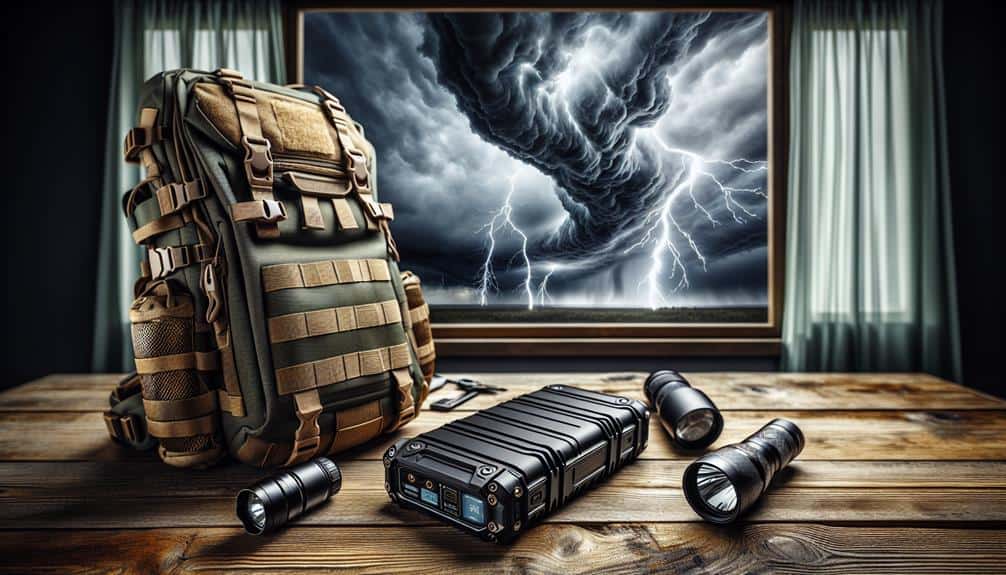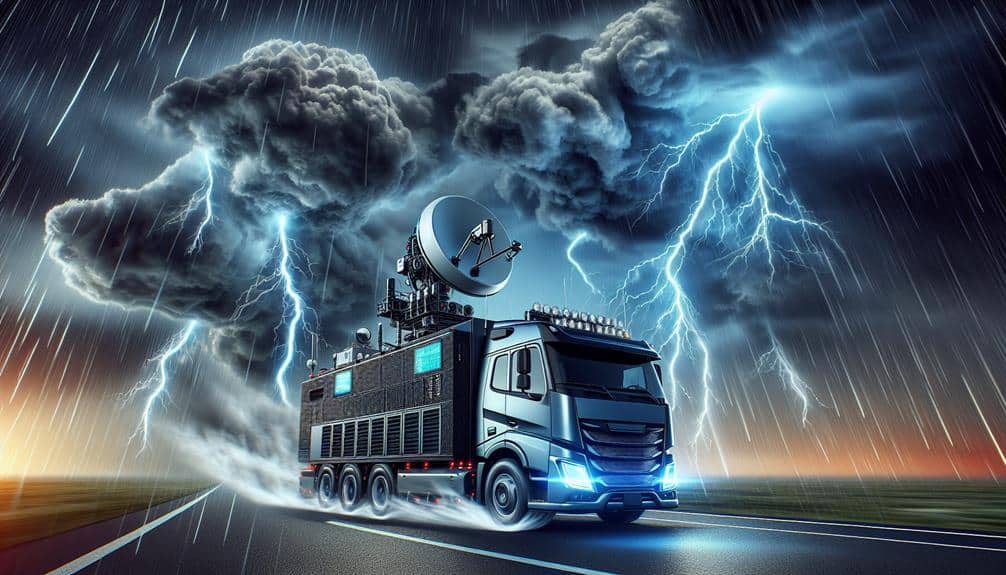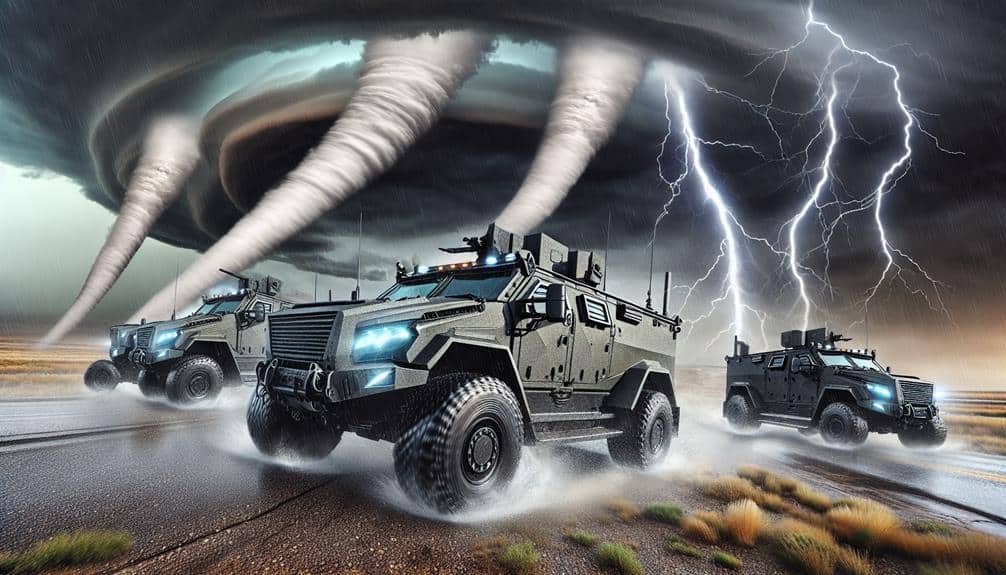When we assemble our storm chasing backpack, certain must-haves like reliable weather radios, portable anemometers, and high-resolution cameras are indispensable tools for capturing data and staying safe. We'll pack GPS navigation devices for real-time updates and mapping, ensuring accurate tracking and emergency communication. Durable power banks with waterproof cases keep our gear charged, while a well-stocked first aid kit addresses potential injuries. Each item's design optimizes functionality in adverse conditions, making them essential for storm chasing. Discover more critical gear that enhances our storm-chasing experience efficiently and safely.
Key Points
- Reliable weather radio for real-time severe weather updates and alerts.
- High-resolution camera with tripod and remote shutter release for capturing detailed storm images.
- GPS navigation device with real-time updates and emergency communication features.
- Durable power bank with high capacity and waterproof protection for device charging.
Reliable Weather Radios
Reliable weather radios are essential tools for storm chasers, as they provide real-time updates and alerts on severe weather conditions. When we're out in the field, emergency alerts can mean the distinction between safety and catastrophe.
A top-quality weather radio needs a strong battery life to guarantee it remains operational during prolonged storm chasing sessions. This secures we stay informed even in remote areas where power sources are scarce.
In addition to battery life, communication options are critical. Modern weather radios come equipped with multiple frequency bands, including NOAA weather channels and AM/FM bands, enhancing our ability to receive relevant updates. Some models even offer two-way communication capabilities, allowing us to relay information within our team, increasing overall coordination and safety.
A waterproof design is non-negotiable for storm chasers. Given the unpredictable nature of severe weather, our equipment must withstand torrential rain and high humidity. Waterproof weather radios ensure that critical updates continue to reach us, regardless of environmental conditions.
Portable Anemometer
A portable anemometer is essential for obtaining accurate wind measurements in the field.
We need a device that's not only precise but also easy to carry and built to withstand harsh conditions.
With reliable data, we can make informed decisions and guarantee our safety during storm chasing.
Accurate Wind Measurements
To capture precise wind speed data, we rely on a portable anemometer, an essential tool for any storm chaser. This compact device provides real-time measurements of wind speed and direction, offering vital insights into storm speed and behavior. When we're out in the field, understanding wind dynamics isn't just about gathering data; it's about safety and making informed decisions rapidly.
Portable anemometers today come equipped with advanced tracking technology that allows us to pinpoint wind direction with exceptional accuracy. This capability is essential when we're monitoring storm speed and trajectory. Knowing the exact path of a storm helps us stay ahead of extreme weather conditions, ensuring we maintain a safe distance while still capturing valuable data.
Moreover, accurate wind measurements are pivotal for emergency response teams. The data collected enhances predictive models, enabling more effective deployment of resources. By providing real-time updates, we contribute to a broader network of information that can save lives and reduce property damage.
In our quest for meteorological freedom, we depend on these high-precision instruments. They empower us to navigate the unpredictable nature of storms, armed with the knowledge that we're equipped to handle whatever comes our way.
Easy to Carry
In addition to their precision, portable anemometers are designed for easy transport, guaranteeing that we can quickly and efficiently move from one location to another during storm-chasing expeditions. These compact devices provide essential wind speed data while maintaining lightweight comfort, making them an indispensable tool for our journeys.
Given the dynamic nature of storm chasing, the portability of anemometers allows us to react swiftly to changing weather conditions without being weighed down by cumbersome equipment. Equipped with waterproof protection, these anemometers are built to withstand harsh environments, ensuring their functionality even in the most adverse weather conditions. This feature is vital for maintaining consistent data collection, regardless of the storm's intensity.
Additionally, their design incorporates quick access and secure storage, allowing us to retrieve and stow these devices with minimal effort. This combination of accessibility and protection guarantees that our anemometers remain readily available when precise wind measurements are needed most.
Durable and Reliable
Recognizing the vital need for dependable equipment in storm-chasing, we prioritize portable anemometers that are engineered for durability and reliability. Anemometers are essential for measuring wind speed and direction, important data points for both safety and scientific analysis.
We select devices constructed with rugged materials that withstand harsh environmental conditions, guaranteeing our measurements are accurate even in the most turbulent storms.
Waterproof gear is non-negotiable. Our chosen anemometers feature robust sealing and corrosion-resistant components to function flawlessly in wet and windy conditions. This waterproof capability ensures that our data collection isn't compromised by rain or moisture, which are inevitable in storm-chasing scenarios.
Equally important is the need for lightweight equipment. We opt for models that are compact and easy to carry without sacrificing functionality. This allows us to maintain agility and freedom of movement, essential when speed and quick decision-making are required.
Adhering to stringent safety precautions, we make sure our anemometers are integrated with our broader emergency supplies. Having reliable wind data enables us to make informed decisions that keep us out of harm's way.
High-Resolution Camera

A high-resolution camera is vital for capturing detailed images of storm structures, lightning, and other atmospheric phenomena. When we're storm chasing, we need equipment that not only offers high pixel count but also excels in low-light performance and rapid shutter speeds. A camera with at least 20 megapixels and an ISO range expandable to 51200 or higher is ideal for capturing the intricate details of storm clouds and the fleeting moments of a lightning strike.
In addition to the camera itself, camera accessories play an important role in our success. A sturdy tripod ensures stability during long exposure shots, while a remote shutter release helps eliminate camera shake. Extra batteries and memory cards are necessary, given the unpredictable nature of storm timing and location.
Photography techniques also matter. We should employ techniques like bracketing to make sure we capture the full dynamic range of a scene. High Dynamic Range (HDR) imaging can bring out the nuanced details in both the dark storm clouds and the bright lightning strikes. Additionally, using manual focus allows us to maintain sharpness in challenging lighting conditions.
When we're storm chasing, having a dependable GPS navigation device is vital for both safety and effectiveness. We'll focus on essential GPS features like real-time weather updates, durable design, and precise geolocation.
Additionally, we'll review top brands known for their reliability and performance in extreme conditions.
Essential GPS Features
Given the unpredictable nature of severe weather, it's important that our GPS navigation devices offer real-time updates, strong signal reliability, and detailed mapping capabilities. These features are vital for maintaining accurate GPS tracking during storm chasing.
Real-time updates guarantee we receive the latest weather data, allowing us to anticipate and react to sudden changes in storm patterns. Strong signal reliability is indispensable; without it, our GPS devices could lose connection at critical moments, leaving us vulnerable.
Emergency communication is another necessary feature. In the event we find ourselves in a precarious situation, being able to send out a distress signal or communicate our exact location quickly can be life-saving.
Advanced mapping software should integrate seamlessly with storm monitoring systems, providing layered views of weather fronts, precipitation levels, and wind speeds. This combination enables us to make informed decisions about our routes and safety.
Additionally, the mapping software must offer topographical details to navigate challenging terrains effectively. High-resolution maps that update dynamically will help us avoid obstacles and find the safest paths.
Reliable Brands Overview
In evaluating the most dependable GPS navigation devices for storm chasing, we should focus on brands recognized for their technological innovation, sturdy performance, and user trust. Garmin, a pioneer in GPS technology, offers devices with advanced features and a user-friendly interface. Their models often include waterproof protection and a lightweight design, ensuring they endure harsh weather conditions without adding unnecessary bulk to our gear.
Another top contender is TomTom, acclaimed for their intuitive software and real-time traffic data. Their devices seamlessly integrate with various storm tracking applications, providing us with precise navigation and up-to-date weather information. TomTom's emphasis on user experience guarantees that their devices are both easy to operate and dependable in critical situations.
Durable Power Banks

To secure our devices remain operational during extended storm chasing ventures, we need power banks that are both high-capacity and exceptionally sturdy. These power banks should ideally offer a capacity of at least 20,000mAh to guarantee multiple charges for our devices.
In addition to high-capacity, incorporating solar chargers into our emergency supplies can provide an alternative power source when traditional charging options are unavailable, especially useful during extended periods in remote locations.
Durability is paramount; we can't afford to have our power sources fail under extreme conditions. Opting for power banks encased in waterproof cases ensures that they remain functional even during heavy rains or accidental splashes. These cases often comply with IP67 or IP68 ratings, indicating they can withstand water submersion and dust ingress, making them ideal for storm chasing expeditions.
Backup batteries also play a critical role in our preparedness. They offer redundancy, guaranteeing that even if one power source depletes or malfunctions, we've alternatives at hand.
Power banks featuring fast charging technology and multiple USB ports can simultaneously charge several devices, from cameras to communication gear, thus upholding our operational efficiency. By prioritizing high-capacity, durable power banks, we secure our freedom to explore and document the fiercest storms.
First Aid Kit
A well-stocked first aid kit is essential for addressing potential injuries and ensuring our safety during storm chasing expeditions. We need to anticipate various scenarios where quick access to emergency supplies can make a critical difference.
Our kit should include essential tools like adhesive bandages, antiseptic wipes, gauze pads, and medical tape to handle minor cuts and abrasions. Additionally, we must carry a digital thermometer, tweezers, and scissors for more precise interventions.
A detailed first aid kit also contains medications such as pain relievers (e.g., ibuprofen or acetaminophen), antihistamines, and antibiotic ointments. Including a CPR face shield and a compact emergency blanket adds layers of preparedness, addressing both immediate medical needs and exposure issues.
Remember, storm chasing takes us into unpredictable environments, where emergency medical assistance might be delayed.
Scientific data supports the inclusion of these items: studies show that prompt application of first aid can considerably reduce the severity of injuries and improve outcomes. By equipping ourselves with a robust first aid kit, we empower our team to respond swiftly and effectively to any medical emergencies, thereby enhancing our safety and freedom to explore extreme weather phenomena.
Frequently Asked Questions
What Type of Clothing Should I Wear While Storm Chasing?
When storm chasing, we should prioritize layering strategies for protection. Waterproof gear and accessories are essential to stay dry. Technical fabrics provide insulation and breathability, ensuring we maintain comfort and mobility in unpredictable weather conditions.
How Do I Keep My Electronics Safe During a Storm?
To keep our electronics safe during a storm, we should use waterproof cases to prevent water damage and pack surge protectors to shield against electrical surges. This method guarantees maximum protection, allowing us to focus on the adventure.
Are There Specific Apps That Storm Chasers Use for Real-Time Updates?
Yes, we use specific apps for storm tracking and emergency alerts. RadarScope and Storm Chaser are essential for real-time updates. These tools provide precise data, empowering us to make informed decisions while chasing storms safely and freely.
What Are the Best Footwear Options for Storm Chasing?
When it comes to the best footwear options for storm chasing, we recommend waterproof boots and traction sandals for wet conditions, lightweight sneakers for agility, and durable boots for rugged terrain. Each guarantees safety and freedom in unpredictable weather.
How Can I Ensure My Vehicle Is Prepared for Storm Chasing?
To prepare our vehicle for storm chasing, we conduct a thorough vehicle inspection, stock emergency supplies, and adhere to safety precautions. We also practice advanced driving techniques, ensuring our readiness for unpredictable weather conditions.

